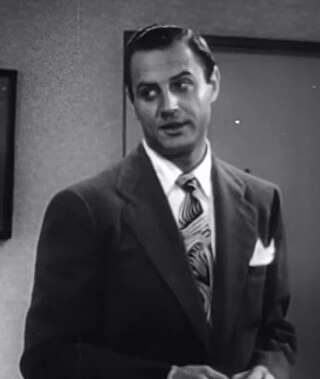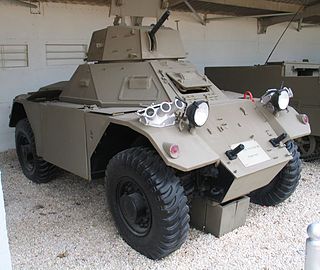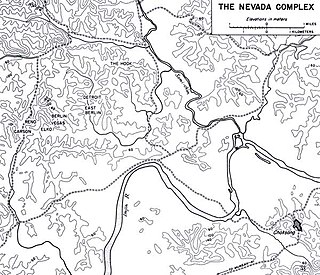
William Broderick Crawford was an American actor. He is best known for his portrayal of Willie Stark in the film All the King's Men (1949), which earned him an Academy Award and a Golden Globe Award. Often cast in tough-guy or slob roles, he later achieved recognition for his starring role as Dan Mathews in the crime television series Highway Patrol (1955–1959).

The Battle of Mount Longdon was fought between the British 3rd Battalion, Parachute Regiment and elements of the Argentine 7th Infantry Regiment on 11–12 June 1982, towards the end of the Falklands War. It was one of three engagements in a Brigade-size operation that night, along with the Battle of Mount Harriet and the Battle of Two Sisters. A mixture of hand-to-hand fighting and ranged combat resulted in the British occupying this key position around the Argentine garrison at Port Stanley. The battle ended in a British victory.

The East Tyrone Brigade of the Provisional Irish Republican Army (IRA), also known as the Tyrone/Monaghan Brigade was one of the most active republican paramilitary groups in Northern Ireland during "the Troubles". It is believed to have drawn its membership from across the eastern side of County Tyrone as well as north County Monaghan and south County Londonderry.

William Boyett was an American actor best known for his roles in law enforcement dramas on television from the 1950s through the 1990s.

Brad Dexter was an American actor and film producer. He is known for tough-guy and western roles, including the 1960 film The Magnificent Seven (1960), and producing several films for Sidney J. Furie such as Lady Sings the Blues. He is also known for a short marriage to Peggy Lee, a friendship with Marilyn Monroe and for saving Frank Sinatra from drowning. Dexter's tough-guy roles contrasted with his easygoing and friendly real-life personality.
This is a chronology of activities by the Provisional Irish Republican Army (IRA) from 1970 to 1979.

The South Armagh Brigade of the Provisional Irish Republican Army (IRA) operated during the Troubles in south County Armagh. It was organised into two battalions, one around Jonesborough and another around Crossmaglen. By the 1990s, the South Armagh Brigade was thought to consist of about 40 members, roughly half of them living south of the border. It has allegedly been commanded since the 1970s by Thomas 'Slab' Murphy who is also alleged to be a member of the IRA's Army Council. Compared to other brigades, the South Armagh IRA was seen as an 'independent republic' within the republican movement, retaining a battalion organizational structure and not adopting the cell structure the rest of the IRA was forced to adopt after repeated intelligence failures.

Platoon Leader is a 1988 war film set in the Vietnam War and directed by Aaron Norris ; it stars Michael Dudikoff and Michael DeLorenzo and was filmed in South Africa. It is loosely based on James R. McDonough's memoir of the same name.

The Battle of Hill Eerie refers to several Korean War engagements between the United Nations Command (UN) forces and the Chinese People's Volunteer Army (PVA) in 1952 at Hill Eerie, a military outpost about 10 miles (16 km) west of Ch'orwon. It was taken several times by both sides; each sabotaging the others' position.

The Battle of the Tenaru, sometimes called the Battle of the Ilu River or the Battle of Alligator Creek, was a land battle between the Imperial Japanese Army and Allied ground forces that took place on 21 August 1942, on the island of Guadalcanal during the Pacific campaign of World War II. The battle was the first major Japanese land offensive during the Guadalcanal campaign.
James H. Diamond was a United States Army soldier and a recipient of the United States military's highest decoration—the Medal of Honor—for his actions in World War II.

Outpost in Morocco is a 1949 American action adventure film directed by Robert Florey, starring George Raft and Marie Windsor. Paul Gerard (Raft), a Moroccan Spahi officer and his French Foreign Legion garrison, holds off attacks from the native tribes of the Emir of Bel-Rashad, the father of Cara (Windsor), the woman he loves. As a rarity amongst American films of the Foreign Legion genre, the Legion cooperated with the producers. A second unit led by Robert Rossen filmed scenes in Morocco. Some of the large-scale action scenes of the film were reused in Fort Algiers and Legion of the Doomed.
The Korangal Valley campaign was a series of military operations conducted by ISAF forces against Taliban and other local insurgents in the Korangal Valley in Kunar province, Afghanistan, from October 2004 to April 2010. The campaign ended with a US withdrawal from the valley, after suffering heavy casualties, and a Taliban takeover of the area.
This is a chronology of activities by the Provisional Irish Republican Army (IRA) from 1980 to 1989. For actions before and after this period see Chronology of Provisional Irish Republican Army actions.

Eight Iron Men is a 1952 American World War II drama film directed by Edward Dmytryk and produced by Stanley Kramer. It stars Bonar Colleano, Arthur Franz, Lee Marvin, Richard Kiley and Mary Castle. Lee Marvin's powerful performance as the squad's leader ratchets up the suspense along with Dmytryk's noir style direction and J. Roy Hunt's deft cinematography.

On 2 May 1974 the Provisional Irish Republican Army (IRA) attacked a British Army base manned by the Ulster Defence Regiment (UDR) near the Northern Ireland–Republic of Ireland border at Clogher, County Tyrone. The IRA unit engaged the small base with automatic weapons, rockets and improvised mortars. Ferret armoured cars were deployed to the scene and a fierce firefight erupted. The IRA withdrew behind the border with the Republic. The assault on the outpost killed greenfinch Eva Martin and wounded another UDR soldier.

The Outpost is a 2019 American war film directed by Rod Lurie, based on the 2012 non-fiction book The Outpost: An Untold Story of American Valor by Jake Tapper, about the Battle of Kamdesh in the War in Afghanistan. It stars Scott Eastwood, Caleb Landry Jones, Orlando Bloom, Jack Kesy, Cory Hardrict, Milo Gibson, Jacob Scipio, Will Attenborough, and Taylor John Smith.
The Battle of Bunker Hill was fought between 9 August and 30 September 1952 during the Korean War between United Nations Command (UN) and Chinese forces over several frontline outposts.
The First Battle of the Hook was fought between 2 and 28 October 1952 during the Korean War between United Nations Command (UN) and Chinese forces over several frontline outposts.

The Battle of the Berlin Outposts and Bunker City was fought between 7 and 27 July 1953 during the Korean War between United Nations Command (UN) and Chinese forces over several frontline outposts.














